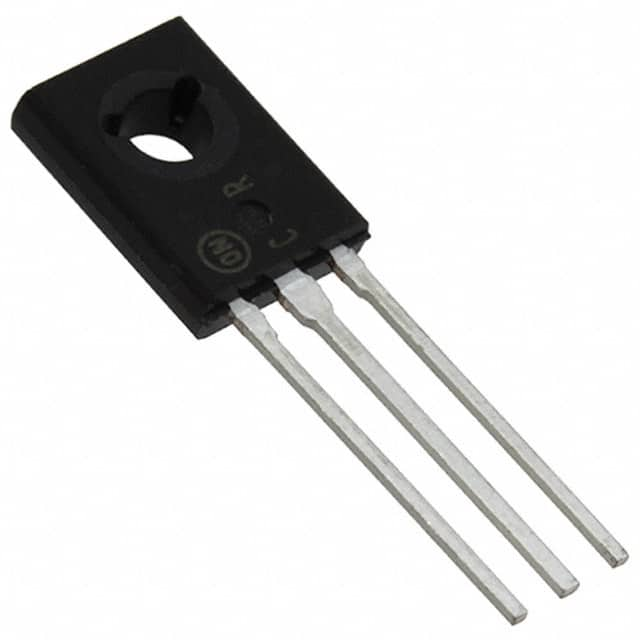Consulte las especificaciones para obtener detalles del producto.

BD438G: Product Overview and Specifications
Introduction
The BD438G is a semiconductor device belonging to the category of PNP transistors. It is commonly used in electronic circuits for amplification, switching, and voltage regulation. This entry provides an overview of the BD438G, including its basic information, specifications, pin configuration, functional features, advantages and disadvantages, working principles, application field plans, and alternative models.
Basic Information Overview
- Category: Semiconductor, PNP Transistor
- Use: Amplification, Switching, Voltage Regulation
- Characteristics: High current gain, Low saturation voltage
- Package: TO-126
- Essence: Silicon PNP Epitaxial Planar Transistor
- Packaging/Quantity: Typically available in reels or tubes containing multiple units
Specifications
- Collector-Emitter Voltage (VCEO): 45V
- Collector-Base Voltage (VCBO): 45V
- Emitter-Base Voltage (VEBO): 5V
- Collector Current (IC): 4A
- Power Dissipation (PD): 40W
- Transition Frequency (fT): 30MHz
- Operating Temperature Range: -65°C to 150°C
Detailed Pin Configuration
The BD438G transistor has three pins: 1. Collector (C): Connected to the positive supply voltage in most applications. 2. Base (B): Controls the transistor's conductivity when a small current is applied. 3. Emitter (E): Connected to the ground in most applications.
Functional Features
- High current gain allows for efficient signal amplification.
- Low saturation voltage minimizes power loss during switching operations.
- Fast switching speed enables rapid response in electronic circuits.
Advantages and Disadvantages
Advantages
- High current gain for effective signal amplification.
- Low saturation voltage reduces power dissipation.
- Fast switching speed for responsive circuit operation.
Disadvantages
- Limited maximum collector-emitter voltage compared to some alternative models.
- Moderate transition frequency may restrict high-frequency applications.
Working Principles
The BD438G operates based on the principles of PNP transistor action. When a small current flows into the base terminal, it controls a much larger current between the collector and emitter terminals. This property enables the transistor to amplify signals or act as a switch in electronic circuits.
Detailed Application Field Plans
The BD438G is widely used in various electronic applications, including: - Audio Amplifiers - Power Supplies - Signal Switching Circuits - Voltage Regulators - Motor Control Circuits
Detailed and Complete Alternative Models
Some alternative models to the BD438G include: - BD437G: Similar characteristics with lower collector current rating. - BD439G: Higher collector current rating with comparable voltage ratings. - 2N3906: Commonly used PNP transistor with different package and characteristics.
In conclusion, the BD438G PNP transistor offers high current gain, low saturation voltage, and fast switching speed, making it suitable for a wide range of electronic applications. Understanding its specifications, pin configuration, functional features, and alternatives can aid in effectively integrating this component into electronic designs.
Word Count: 470
Enumere 10 preguntas y respuestas comunes relacionadas con la aplicación de BD438G en soluciones técnicas
What is the BD438G transistor used for?
- The BD438G is a PNP bipolar junction transistor commonly used for general-purpose amplification and switching applications.
What are the key specifications of the BD438G?
- The BD438G typically has a collector current (IC) rating of 4A, a collector-emitter voltage (VCE) rating of 45V, and a power dissipation (Ptot) of around 36W.
Can the BD438G be used for audio amplifier circuits?
- Yes, the BD438G can be utilized in audio amplifier circuits due to its high current and voltage ratings.
Is the BD438G suitable for low-power applications?
- No, the BD438G is more suited for medium to high-power applications due to its higher current and voltage ratings.
What are some typical applications of the BD438G?
- Common applications include motor control, relay drivers, audio amplifiers, and general switching circuits.
Does the BD438G require a heat sink for operation?
- It is recommended to use a heat sink when operating the BD438G near its maximum power dissipation to ensure proper thermal management.
What are the pin configurations of the BD438G?
- The BD438G typically has a standard TO-126 package with the emitter, base, and collector pins labeled accordingly.
Can the BD438G be used in high-frequency applications?
- The BD438G is not optimized for high-frequency applications due to its slower switching speeds.
Are there any common failure modes associated with the BD438G?
- Overheating due to inadequate thermal management and exceeding maximum ratings are common causes of failure.
Where can I find detailed technical information about the BD438G?
- Detailed datasheets and application notes for the BD438G can be found on semiconductor manufacturer websites or distributor platforms.

